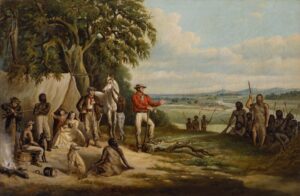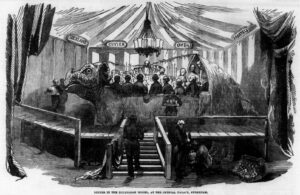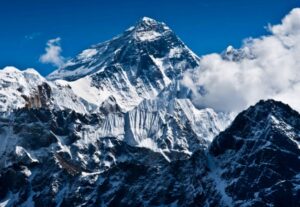From its first ascent in 1953 to the end of the autumn season of 1982, 133 climbers summited Mount Everest. Seven of them went without supplemental oxygen and one of them, Reinhold Messner, did so twice without O2. During this period, 48 climbers lost their lives.
The 1982 climbing season was particularly tragic. Nine mountaineers died, three in the spring (among them Pete Boardman and Joe Tasker), and six in the autumn. But the death toll did not deter two teams from attempting winter climbs the same year.
Context: winter climbs in the early 1980s
Everest was the first 8,000m peak to be climbed in winter. Leszek Cichy and Krzysztof Wielicki summited Everest in winter for the first time on February 17, 1980, using supplemental oxygen.

The Polish team during their 1979-1980 winter expedition. Photo: Bogdan Jankowski
Before 1982, there were two earlier attempts to climb Everest in winter. In 1980, the Japan Winter Everest Expedition team, led by Naomi Uemura, arrived at Base Camp on November 27. But bad weather hindered them, and in January 1981, they aborted at 8,000m. According to The Himalayan Database, they used O2 at night.
That same winter, the British Winter Everest Expedition group, led by Alan Rouse, arrived on December 6 and attempted the Lho La-West Ridge route, without bottled oxygen. Bad weather forced them to retreat from 7,300m.
Winter 1982
On November 21, 1982, an international team (French/Belgian/Italian/Swiss) arrived at Base Camp. Led by Michel Metzger, they climbed without O2. However, the Khumbu Icefall was very dangerous near the Southwest Face, and they stopped at 6,500m. They changed their route and instead asked for a permit for the West Ridge.
The team then followed the Yugoslavian route. Two members, Marc Batard and Louis Auduobert turned back at 7,650m because of very strong winds. The rest of the team wanted to make a final attempt.
Soon, Belgian Jean Bourgeois showed symptoms of cerebral edema and he decided to descend quickly, alone. But on his way down, he crossed to the Tibetan side of the mountain. He reached the Rongbuk Monastery, and after several days, the first village.
Authorities detained him and interrogated him. Meanwhile, the other members of the team desperately searched for him for six days. They thought that Bourgeois might have fallen into a crevasse. The rest of the team eventually left Base Camp on December 31.
On January 11, the Chinese authorities drove Bourgeois to the Tibet-Nepal border. From there, he completed a hazardous trek before he could find a bus to Kathmandu. Finally, he met his teammates, who by now believed that he was dead.
Yasuo Kato
On December 3, 1982, a nine-member Japanese team also arrived at Base Camp. Led by Yasuo Kato, they chose the Southeast Ridge route and planned to use oxygen.
Kato’s previous climbs were always on the edge. In 1969, at age 20, he was a member of the Japanese team that established the third route on the North Face of the Eiger, known as the second direttissima route. After 16 days on the wall, climbing in bad weather during the last three days, they topped out on August 15. In a storm, they had to bivouac below the summit.

Kato and his climbing partners after the successful new route on the North face of the Eiger. Photos: via Hume
Only four years later, on October 26, 1973, Kato and Hishashi Ishiguro formed part of a mammoth 50-member Japanese Everest team, led by Michio Yuasa. Both climbers ran out of oxygen, food, and water when they topped out on October 26. Kato suffered frostbite on his toes, but both climbers reached Base Camp alive. This was the first post-monsoon climb in the history of the mountain.
In 1976, Kato climbed Nanda Devi, and in 1981, he summited Manaslu without bottled oxygen.
At the age of 31, on May 3, 1980, Kato summited Everest again. He climbed with oxygen, via the Northeast Ridge. He did the last 100m alone and ran out of oxygen on the summit. He had to a bivouac near the Second Step before continuing his descent. Kato became the first person to climb Everest from both Nepal and Tibet.

Mount Everest from Kala Patthar. Photo: Pavel Novak
The Japanese team, 1982
Yasuo Kato’s team included Yoshimasa Sasaki, Tsutomu Miyazaki, Shoji Nakamura, Takehiro Sekizaki, Shigeru Suzuki, Toshiaki Kobayashi, Nawang Yonden Sherpa, and Pemba Norbu Sherpa.

The Khumbu Icefall on Everest. Photo: Tashi Lakpa Sherpa
Only 10 days after arriving at Base Camp, the Japanese team established Camp 2 at 6,650m. According to their trip report, the Khumbu Icefall — which had scared off the French team that same winter — “was not that big, just little serac collapse.”
They continued up, climbing without supplemental oxygen to Camp 3 on the Southeast Ridge on December 18. They were progressing fast.

The normal (Southeast Ridge) route on Everest. Photo: Pinterest
On December 22, Kato reached the base of the South Col (7,900m), where he planned a solo summit push. On December 23, “Kato counted on the belief that the jet stream rises clear of the mountain every few weeks for two or three days. He planned to launch an alpine-style attempt in that brief, calm period, with Kobayashi following in support,” Thomas Holzel wrote in the American Alpine Journal in 1983.
However, at 8,100m he had to turn around. The weather turned bad, with 50-60kph winds and -40°C temperatures. Kato struggled to remain upright, and his radio froze.

The South Col (7,900m). The pinnacle above is the South Summit. Photo: Wikipedia
A second attempt
A few days later, on December 27, he tried again, this time with Kobayashi. Both climbers were on O2 and left Camp 4 at 5 am. Five hours later, the two climbers were already at 8,400m. Kobayashi ascended with Kato to 8,800m but stopped there, exhausted and with the beginnings of frostbite. Kato reached Everest’s South Summit at 1:50 pm. Two hours later, he summited Everest.

The view from 8,500m on Everest. Photo: Kenton Cool
From experience, Kato knew that a bivy would be necessary again. On the descent, Kato met up with Kobayashi. Both decided to bivouac just below the South Summit. They had run out of oxygen. The weather turned harsh, and it snowed all night.
Their teammates contacted them to ask if they wanted the Sherpas to go up to the South Col to rescue them. During this radio conversation, featured in a Japanese documentary about their climb, you can hear the strength of the wind.
However, Kato refused rescue. “No, [rescue] won’t be necessary,” he insisted. “You don’t have to send them. Both of us are well and we’ve got a good bivouac. I’ll call you tomorrow at 7 am. Good night.”
Kato’s voice was confident and he seemed in good spirits. “During each of his other two Everest ascents, he had bivouacked above 8,000m without equipment. Now being fully prepared, he expected no difficulties,” a trip report detailed.

Looking towards the summit of Everest from the South Summit. Photo: Guy Cotter/Adventure Consultants
Mortally cold
Unfortunately, a huge winter storm hit the region that night. Winds reached 200kph, and the temperature dropped to -43°C. Kato and Kobayashi never returned. According to other climbers, there was little snow on the Southeast Ridge, and the pair might not have been able to dig a snow cave. It is possible that they spent the night in the tent that Kobayashi carried up the mountain. Perhaps the hurricane-force wind blew them away.
On December 30, 1982, the search for Kato and Kobayashi ended. Kato was the first person to reach the summit of Everest in winter, solo. It was his third Everest ascent.
Five months later, Sherpas found Kato’s yellow climbing helmet and some exposed film. Later, Kobayashi’s diary was found near the South Col.
Like a samurai, who had boldly faced the Japanese gods of wind and thunder with an ice ax instead of a sword, Kato gave his best to the last.

Yasuo Kato. Photo: Yasuo Kato Archive





